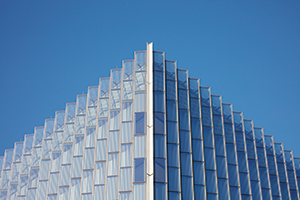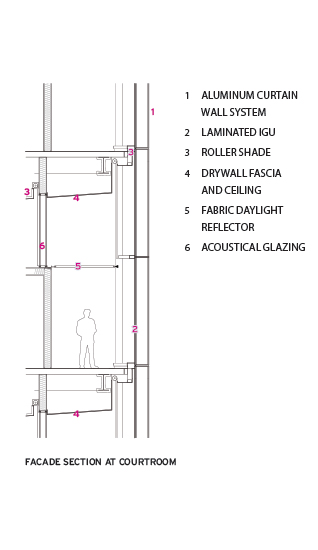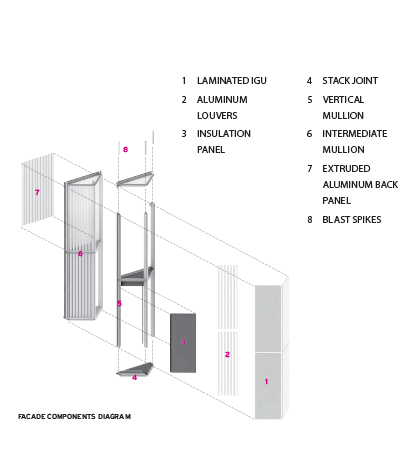Technical Sidebar: Pleats, Please
The modern courthouse is a paradoxical building type— it is part of the city but should also be apart from the city—magisterial and imposing, yet also a public place where almost everyone ends up eventually, even if just for jury duty.
Additional Information:
Jump to credits & specifications
The architects behind the new United States Courthouse in downtown Los Angeles were acutely aware of the challenges they faced in creating a major civic presence while engaging with a rapidly changing neighborhood, one that is increasingly used by pedestrians and dotted with a constellation of high-profile cultural and public buildings. The courthouse, on a sloping site facing 1st Street, is two blocks down from Frank Gehry’s 2003 Walt Disney Concert Hall, with its silvery furls crowning the hilltop, and two blocks up from Morphosis’s 2004 CalTrans Center, with its tough facade and expansive plaza. While it is quieter than either of those neighbors, its strong, simple form—a floating ice cube, wrapped in gleaming vertical pleats of glass—make it a dramatically faceted gem in a still-evolving urban realm.
The project had a somewhat tortured history, with the Los Angeles office of Skidmore, Owings & Merrill (SOM), led by Craig Hartman, competing for it twice. Under the General Services Administration (GSA) Design Excellence program, the firm lost a first competition to Perkins+Will, which had designed a 17-story tower that would have cost a reported $1.1 billion. A Congressional budget slash killed that scheme: from a careful analysis of the site and the demands of the program. Elevating the cube on the columnless recessed base was especially brilliant: it helped resolve the sharp slope—there is about a 27-foot drop from the high end of the site to the low—and bolstered security requirements that otherwise might have meant a big setback. Instead, the courthouse has a friendly urbanity on the street, with the cantilevered entrance “porch” and wide steps. The move also left more room for a garden with switchback ramps that allow a wheelchair user to navigate around the steep public sidewalk. And the cube form, lifted up, imparts a civic gravitas—what Hartman calls “a Euclidean clarity befitting a courthouse.”
The vertical folded glass exterior also sprang from the site analysis. While the street plan of downtown L.A. is a grid, it is 38 degrees off the points of the compass. The pleats of the glass skin, set so that they face due north–south or roughly east–west, allow the building to be tuned to the sun, by shading certain faces of the triangles.
The concrete-and-steel composite structure is anchored by enormous concrete cores that contain elevators and services, while vertical steel hangers, suspended in tension from a hat truss at the top, are attached to beams, which support the slabs, which in turn support the curtain wall. The strategy eliminated the need for perimeter columns. Adding to the drama of the floating cube is its shimmering skin, which shifts from silver and gray to pink and lavender, depending on the weather, time of day, and the viewer’s vantage point.
You enter the 630,000-square-foot courthouse under the hovering wings of an American eagle and the seal of the United States, etched subtly into the glass facade, while the Indiana limestone of the exterior base is carried into the walls of the lobby. The material palette inside is minimal—the pale stone, the white marble floor—but the architectural elements that really count are space and light: daylight pours into the soaring 10-story skylit light court, or atrium, creating a luminous, serene grandeur. Ringing the atrium are walkways with glass balustrades; criss-crossing the lofty void are bridges that are not stacked directly above each other but staggered, creating a dynamic, and less vertiginous, space.
“Light is at the very core of the design concept,” says Hartman. “It is a metaphor for judicial fairness and is meant to create an atmosphere of calm and equanimity, in spaces that are often highly charged for people who come here. And, equally important, the natural light radically reduces the need for artificial light and is key to the building’s highperformance environmental strategy.” From 900 solar panels on the roof to recycled graywater for irrigating the garden, the courthouse is expected to be certified LEED Platinum.
While administrative and federal marshal facilities occupy the first few floors, the courtrooms begin on the fifth level, with two pairs on opposite sides of each floor, for a total of 24 courtrooms in the building. Those upper reaches of the courthouse include light-filled lounge areas linked by staircases, at the front end of the building, overlooking the city.
American white oak millwork brings warmth to the fairly traditional courtrooms, but the architects have ingeniously brought in daylight via interior clerestories at the back of each room—drawing light from the atrium—and above and behind the judge’s bench, where sunlight spills in from a private corridor. Those corridors run along the interior perimeter of the curtain wall and lead to the judges’ chambers and their dedicated elevators. The courtroom ceilings are canted out, at front and back, to further disperse the light, while the walls of cast gypsum, with soft vertical folds, also enhance the light. “Before, I was in a very dark courtroom, with low ceilings, and always felt as if I was sort of in a dungeon,” says Margaret Morrow, the former U.S. District judge who represented her fellow judges throughout the design process. “It just improves the mood in the courtroom to have it be so light and airy.”
When SOM won the commission, Morrow presented the architects with a list of 10 essential principles, including “High Sustainability” and “Bring Best Value for Taxpayer!” Two goals especially stand out: “Must Fit the Community” and “21st-century and Timeless Design.” These are not easy benchmarks to attain in any design, but the verdict is in. The L.A. courthouse has more than met the court’s high standards of proof on all counts.
Sidebar: Pleats, Please

SOM conceived the new U.S. Courthouse in Los Angeles as a glass cube cantilevered from a solid base. The idea was that the transparency of the building’s glazed facade, and the sunlight that would stream through it, would serve as metaphors for the justice system. But there was one major obstacle: the urban grid in this part of the city is 38 degrees off the north-south axis, offering a less than optimum solar orientation for control of heat gain and glare, explains Jose Palacios, an SOM design director.
The architects’ solution was a pleated facade made of 6-foot-wide components that are triangular in plan and span the building’s unusually tall (20-foot) floor-to-floor height. The typical curtain wall module, divided into lower and upper portions by an intermediate mullion, has two stacked insulated glazing units (IGUs) that face north or south—depending on the orientation of the facade—and two that face roughly east or west. The bottom half of each module comprises one vision panel and a second panel that Palacios describes as a “shadow box.” Here vertical aluminum louvers and an insulation layer are inserted behind the IGU in order to mitigate the undesirable effects of the sun. The upper part of each unit essentially repeats the lower half, but includes an aluminum back panel in order to conceal a mechanical plenum.
This curtain wall approach, which cuts incident solar gain almost in half compared to a more conventional glass facade, is slightly adapted throughout the building to achieve different interior effects. For instance, at perimeter corridors just behind the courtrooms, where the ceilings are high and the mechanical plenum shallow, the upper aluminum back layer is omitted. This allows daylight to pour into the corridors, bounce off stretched fabric lightshelves, through interior clerestory windows, and into the courtrooms. Automated roller shades at the facade diffuse sunlight when it is at its most intense, while a second set of motorized shades at the clerestories gives each judge control over the environment in his or her courtroom.
In addition to helping modulate daylight and reduce solar gain, the facade strategy offers other benefits. The triangular shape, which has an inherent structural stability, allowed the designers to keep the mullions relatively thin despite stringent requirements for blast resistance and seismic drift, says Palacios.
What’s more, because the curtain wall was unitized and made up of a kit of parts, it could be installed quickly and efficiently. Speed was critical because of the courthouse’s unusual structure, with slabs suspended from a hat truss at the roof. The configuration prevented installation of the curtain wall before the building had been topped out and meant that the project could not employ a typical construction sequence, where facade work follows closely behind pouring of the floor slabs. The highly repetitive nature of the curtain wall was key to keeping courthouse construction on track, despite the project’s “blistering pace,” says Palacios.


CreditsArchitect: Skidmore, Owings & Merrill LLP
Design Build Team Leadership: Craig Hartman, FAIA, SOM Design Partner Paul Danna, FAIA; Jose Palacios, AIA, SOM Design Directors Michael Mann, FAIA, SOM Managing Director J. Marc Kersey, Senior Vice President, Clark Construction Group M. Marshall Singh, Project Executive, Clark Construction Group Greg Groleau, Vice President, Clark Construction Group
SOM Project Team: Gene Schnair, FAIA, Managing Partner Keith Boswell, FAIA, Technical Partner Susan Bartley, AIA, LEED AP, Project Manager Steven Zimmerman, AIA, LEED AP BD+C, Senior Technical Designer Garth Ramsey, Technical Designer Sally Anderson, LEED AP BD+C, AIA, CDT Frank Castillo Kevin Conway, AIA, LEED AP Sean Corriel David Diamond, FAIA Sally Drum Qinghua Fan Emily Farnham, AIA, LEED AP Jordon Gearhart Ben Grobe, AIA, LEED AP BD + C Brian Hart, AIA Viltis Januta, AIA, LEED AP BD + C Winna Japardi Josh Kenin, RA, LEED AP Joanna Lam Isshin Morimoto Julia Ovsenni, AIA, LEED AP BD + C Tanya Paz Maria Sviridova Marc Tanabe Jennifer Williams, ASLA, LEED AP
Design Build Partner/General Contractor: Clark Construction Group, LLC
Clark Construction Group Project Team: Steve Deyer, AIA, LEED® AP Andrew Erdman Sam Hoelscher Bradley B. McDermott Art Vasconcelos
Interior Designer: Skidmore, Owings & Merrill LLP: Naomi Asai Carmen Carasco, AIA Armen Isagholi, AIA, LEED AP BD+C Erin Kasimow Amy Rangel, LEED AP ID+C Bita Salamat, AIA, LEED AP
Engineers: Structural Engineer: Skidmore, Owings & Merrill LLP Mark Sarkisian, PE, SE, LEED Eric Long, PE, SE, LEED Andrew Krebs, PE, SE, LEED Mechanical Electrical Engineer: Syska Hennessy Group Inc. Plumbing Engineer: Southcoast Engineering Group, Inc. Civil Engineer: Psomas Geotechnical Engineer: Haley & Aldrich
Consultants: Accessibility: AA Architecture Interior Planning
Graphics: Skidmore, Owings & Merrill LLP: Lonny Israel, Associate Design Director Dan Maxfield, Designer Pauline Cheng, Designer Page/Dyal Branding and Graphics
Courts Planning, LEED and Security: AECOM
Blast: Applied Research Associates
Food Service: Cini Little International, Inc.
Lighting: HLB Lighting Design
Fire Life Safety: Jensen Hughes
Elevators: Lerch Bates Inc.
Acoustics: Newson Brown Acoustics LLC
Landscape: Mia Lehrer + Associates
Photographer: Bruce Damonte and David Lena
|
SpecificationsStructural System List type, e.g. concrete or steel frame, wood, etc. Composite Special Reinforced Concrete Shear Walls and Wide Flange Steel Framing
Manufacturer of any structural components unique to this project: Steel Fabricator and Erector: The Herrick Corporation Concrete and Rebar Fabricator: Conco Buckling Restrained Braces: Core Brace Exterior Cladding Masonry CMU - Angelus Block Co., Winegardner Masonry Inc. Glazed Block – Trenwyth Industries Metal panels Custom Panels - VNSM Moisture barrier Hot Rubberized Membrane – Henry Co. Below Grade – Grace Construction Products Tank – ITW Polymer Traffic Coating – Neogard Fluid Applied – GE Momentive Sealants Dow, Pecora, GE Momentive Curtain wall Benson Industries, C&C Glass, Larson Engineering Stone Cladding Indiana Limestone, Carrara Marble Co. Soffit Cladding Premiere Tile, Korel Tile Stone Specialist Giovanni D’Angiolo Louvers and Expansion Joints Construction Specialties, Ohio Gratings Inc. Architectural Concrete Shaw & Sons Building Insulation Johns Manville Roofing Roof Sika Sarnafil Single Ply Membrane Green Roof Henry Co. Hot Rubberized Membrane Roof Hatch Bilco Glazing Glass Viracon – Exterior Curtainwall and Skylights Pulp Studio – Elevator Cab Panels GlasPro – Interior Wall Panels Golden Glass Inc – Custom Assemblies TSS Armor – Ballistic Arcadia, Trulite – Acoustical Assemblies Skylights Metcoe Doors Entrances Horton Automatics, Capitol Doors Metal doors Security Metal Products, Assa Abloy Wood doors Eggers Sliding doors Dorma HSW Fire-control doors, security grilles McKeon, Rytec Sound Control Doors Eggers Hardware General Allegion Montgomery Hardware Locksets Schlage Closers LCN Exit devices Von Duprin Pulls CRL/Blumcraft Hinges Ives Specialty Hardware Adams Rite, Glynn Johnson, Folger Adams, National Guard, Pemko, Zero, Rixson, Trimco, Wikk, Lockmasters, Kaba Detention Equipment Southern Folger Interior Finishes Acoustical ceilings Armstrong, PCI, Ceilings Plus, CertainTeed, Conved Wall Technologies Acoustical paneling Rulon International Suspension grid Armstrong, Chicago Metallic Demountable partitions Advanced Equipment Corp. Cabinetwork, paneling and custom woodwork Pacific Architectural Millwork Paints and stains Sherwin Williams Wall coverings Fabric Wallcraft, Carnegie, Astek Inc. Lobby wall paneling Crossville Laminam Plastic laminate Laminart Solid surfacing LG Hausys Floor and wall tile Mosa, Crossville, Daltile, Schluter Resilient flooring Johnsonite, Mannington, Burke, Static Smart, Forbo, Roppe Carpet Bentley, Tangram Raised flooring Haworth Skylight Reflectors, Courtroom Wall Panels Moonlight Molds, Schmitt Contracting Furnishings Office furniture Steelcase Workstations, Knoll Reception furniture Knoll, Davis Fixed seating Pacific Architectural Millwork, Custom Benches Chairs Knoll, Herman Miller, Krug – Courtrooms, Davis – Jury Assembly Tables Knoll, Herman Miller, Bernhardt Upholstery Maharam, Knoll Lighting Downlights Spectrum, Cooper Lighting Metalux Tasklighting Juno Lighting, Birchwood Exterior Bega, Zefiro, Efficient Tec (Lit Rails), BK Lighting, Boca Flasher, Lithonia Specialty Lumini Dimming system or other lighting controls Lutron Egress Isolite Detention New Star Conveyance Elevators/escalators Otis, Gunderson, City Lift Accessibility provisions - Lift T L Shields Plumbing Faucets Moen, Chicago Faucets, Lovair Flush Valves, Toilet Fixtures American Standard, Toto Lavatories Toto, Kohler Sinks Elkay Detention Fixtures Acorn Energy Building automation system Siemens Photovoltaic system Solar World, GLO/Helix, Belco Rainwater collection system Uponor Radiant floor system Uponor Air Diffusers Price Mechanical Displacement Air System ACCO |















Post a comment to this article
Report Abusive Comment